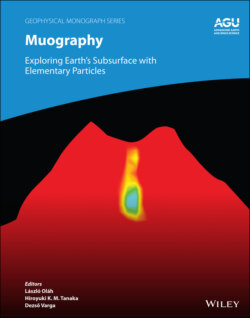Читать книгу Muography - Группа авторов - Страница 31
1.3.5 Underground Water
ОглавлениеRisks in landslips (smaller‐scale landslides, mudslides, debris slides, and flows), landslides (larger‐scale mass movements), and flood in tunnels (for example, the flood accident known as “The Great Spring” inside the Severn Tunnel in 1879) are all related to the existence and mobility of subterranean water. Therefore, monitoring the subsurface water content is a key factor to predict underground‐originated disasters. The subsurface water content has been monitored with water gauges and soil moisture sensors inserted into vertically and horizontally drilled boreholes (Yuliza et al., 2015), however, from only a few data points, it is generally difficult to extrapolate the actual movements of underground water that are affected by the complicated surrounding geology. Deployments of an array of multiple sensors in multiple boreholes are not practical, thus our current quantitative understanding is far from the level of constructing a satisfactory model for prediction. As a consequence, the current risk management is rather palliative, for example, concrete shotcrete to stabilize mechanically unstable slopes or drainage tunnels to lower the level of the underground water table (Tanaka & Sannomiya, 2012).
Muography can measure (i) variations of bulk water contents over a much larger area than possible with a soil moisture sensor or a water gauge; and (ii) the total mass of water, inflow and outgoing, within a given volume. Examples are shown in Fig. 1.8. The extensive precipitation (> 100 mm/day) and muon flux have a negative correlation in the fracture zone associated both with the seismic fault (Fig. 1.8a) (Tanaka et al., 2011) and the landslide fault (Fig. 1.8c) (Azuma et al., 2014). The difference between these faults is either vertical (seismic fault) or horizontal (landslide fault). A delay in timing of the muon flux reduction between higher elevation (700 mrad) and lower elevation (500 mrad) corresponded to the motion of rainwater from a higher place (220 m a.s.l.) to a lower place (185 m a.s.l.), however, no such a delay was observed in the landslide fault. This simultaneous muon flux reduction was consistent with the water gauge results that showed a quick ascent (~15 m) of an underground water table from the steady elevation (480 mrad; dashed line in Fig. 1.8d) within a short time (a few hours) at a local water well (W‐10). The soil underneath an elevation of 480 mrad was already saturated with water. Therefore, there was no rainfall‐muon‐flux correlation at a lower elevation (480 mrad) as shown in Fig. 1.8c.
The precipitation of 100 mm increases the mass of the soil only by 100 kg/m2. The resultant fractional density variations in the target volume will be less than 0.5%; hence the muon flux reduction of less than 1%. Therefore, muography is not so sensitive to the precipitation itself. In the previous cases, muography measured more localized larger‐scale mass movements due to permeation of rainwater and inflation of underground water. Three tons/m2 of water moved through the seismic faults from surface to underground (at a depth of 35 m) within a few days, and 3.6 × 104 tons of water inflow were measured in the underground water pathway. Rainwater gradually permeates to the underground direction, and inflation of underground water gradually propagates to the downstream direction. However, this propagation direction was not so simple. For example, the underground water level that was located closer to the detector did not change at W-9 (~50 m from the detector) (Fig. 1.8c). In general, the increased water flux couldn't be processed uniformly within the complicated underground structure, and the water level locally ascended like drifts of snow or leaves. If there is no water inflow or outgoing, the absolute amount of water situated inside the underground porous media can be derived only when a degeneracy of porosity and fraction of water occupation can be solved by, for example, joint inversion with seismic measurements (Matsushima, 2019).
Figure 1.8 Response of the muon flux to rainfall events. (a) The response in the Itoigawa‐Shizuoka Tectonic Line (ISTL) seismic faults. (b) The geometric configuration of the detector (Mu) and the ISTL seismic faults. The line A–B indicates the estimated fault line. (c) The response in the landslide fault, Shizuoka, Japan. (d) The cross‐sectional view of the geometric configuration of the detector (Mu) and water gauges in water wells (W‐9 and W‐11).
